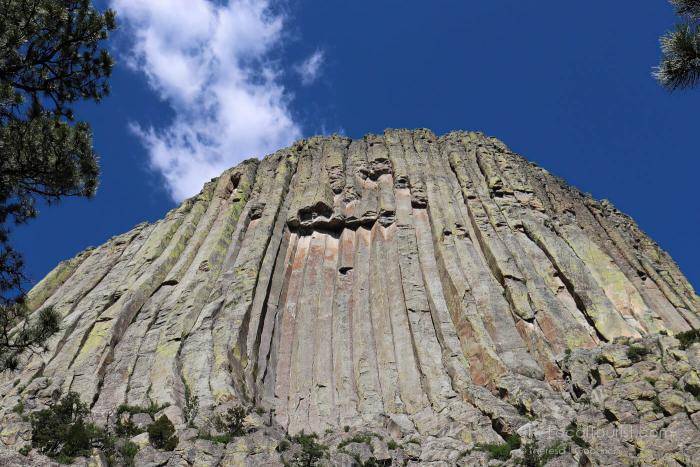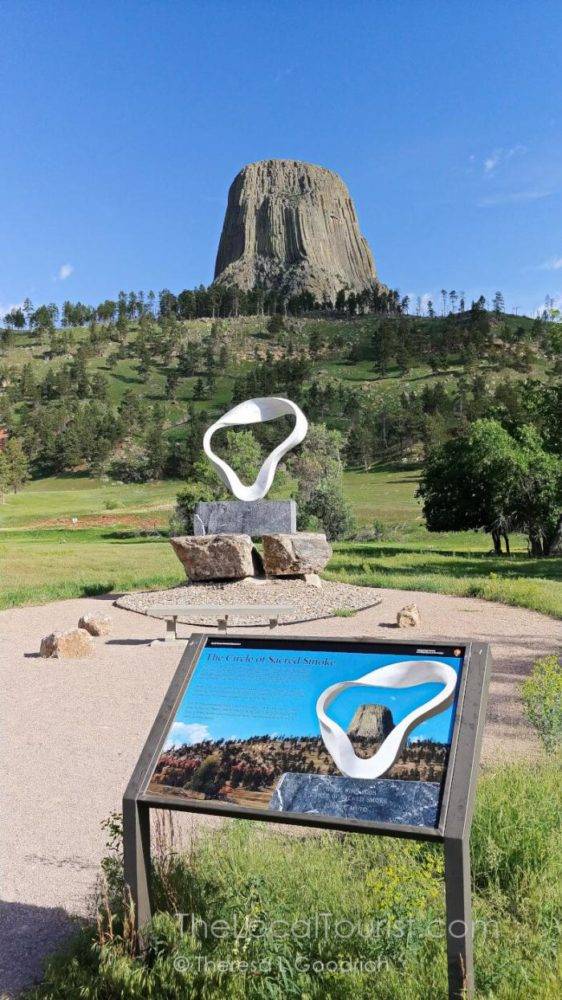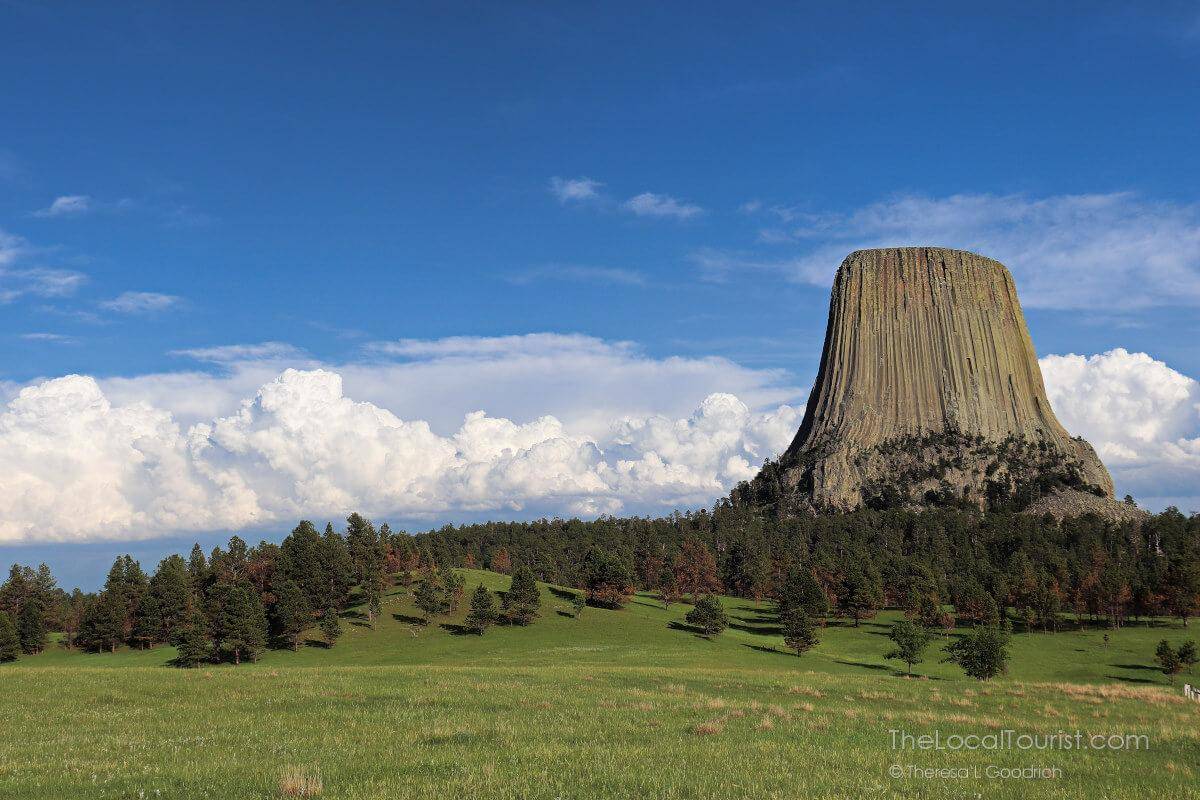In the northeast corner of Wyoming in a county called Crook is Devils Tower National Monument, one of the most recognizable landmarks in the United States.
Surrounded by prairie, the unique fixture shoots straight up into the sky, its distinctive vertical lines looking like a creature had dragged its claws from summit to base.
Being a child of the ‘70s, I have seen Close Encounters of the Third Kind, which means that my first glimpse of the rock formation was not a complete shock to my system. But I still wasn’t prepared for its impact. It’s massive. It’s magical.
It’s a mistake.
The name is, anyway.
Read on to learn more about this sacred Native American site and why Devils Tower National Monument is a clerical error and 14 other things you (probably) didn’t know about this Wyoming landmark.
15 Things You (probably) Didn’t Know About Devils Tower National Monument
1. Devils Tower is the very first National Monument

OK. You probably did know this one. But did you know how and why?
In the late 1800s, more and more people flocked to this unique landmark. Seeing that it was getting out of hand, in 1890, the General Land Office (GLO) ordered that all applications for ownership of Devils Tower and the land around it should be rejected.
This same organization administered the Homestead Act, which parceled out pieces of land to people who wanted to live on it (except the native peoples who were already living on it).
In 1892, the GLO (precursor to the Bureau of Land Management, or BLM) protected the landmark further by making it a temporary forest reserve.
It held that designation until 1906, when President Theodore Roosevelt used his wiles to have Devils Tower declared the first National Monument.

I kinda feel like Teddy pulled a fast one. He’d originally signed the act to prevent looting of Native American ruins and artifacts, a practice that had become an issue in Chaco Canyon and similar archaeological sites in the southwest.
The Antiquities Act, signed on June 8, 1906, gave President Roosevelt, and all subsequent presidents, the power to declare “historic landmarks, historic and prehistoric structures, and other objects of historic or scientific interest” as monuments.
While Devils Tower technically fit those criteria, considering the reason for the act it’s a little surprising that the Wyoming site was chosen as the first officially protected landmark.
Hey, whatever works. I’m just glad he did.
Related: National Park vs National Monument – what’s the difference?
2. The Devils Tower National Monument Visitor Center is historic, too

The ponderosa pine log structure of the Devils Tower National Monument Visitor Center was built in 1935 by the Civilian Conservation Corps and is on the National Register of Historic Places.
Related: Another place the benefitted from the Civilian Conservation Corps was Palo Duro Canyon.
3. Devils Tower is not a volcano

While Devils Tower certainly looks like a volcano, it isn’t. Instead, it’s a unique geologic formation that’s solid all the way through.
It’s made up of columns that are unexpectedly symmetrical and huge chunks lay around the base. When we looked up, we could see where they broke off.
It could be a volcanic plug, which is an igneous intrusion that plugged the flow of the volcano. One of the most popular theories is that it’s a laccolith. In that case, magma lurched to the surface, pushing the rock above it higher.
Instead of breaking through, like a volcano, the magma cooled and became igneous rock.
No matter how it was originally formed, Devils Tower National Monument looks the way it does today because erosion removed the outer sedimentary rock layers, leaving behind a peak that has been a gathering place for humans for 10,000 years.
Be sure to get your road trip planning pages before heading to Devils Tower!
4. The National Park Service sets it on fire

We’d noticed there was very little undergrowth in the forest surrounding Devils Tower, and that’s because the Park Service intentionally starts fires.
Smokey the Bear would not be upset by this. During our hike, we’d seen discolored bark at the base of several trees.
Turns out, ponderosa pines are built for flames. Not only does it take an incredibly hot fire to burn through their thick bark, but their sap is also a fire suppressant.
As a fire gets taller, the lower branches act like a natural sprinkler system.
How cool is that?
It only works if there are regular fires, however. From 1916 until the 1970s the Park Service actively suppressed fires, building up decades of kindling.
Since 1991, Devils Tower National Monument has regularly burned sections of the surrounding forest floor in spring and fall, mimicking the natural cycle.
If you happen to visit and see portions of the park on fire, don’t be alarmed. It’s probably on purpose.
5. You can spend the night at Devils Tower

Camping at the base of Devils Tower National Monument is definitely one of the coolest places I’ve ever pitched a tent.
It’s a basic campground with flush toilets and running water, but no showers or electricity.
It’s in between a prairie dog town and the Belle Fourche River, and the sunrise views are simply magical.
Rates are $20/night for an individual site and $30/night for group sites. The Belle Fourche River campground is open from May through October and campsites are first-come, first-served. Bring cash or check.
6. You can have a drink in the Devils Tower campground

Did you know you can have an adult beverage in National Parks?
That made this beer-loving lady quite happy, especially after filling my fancy-schmancy Growlerwerks uKeg at Sick and Twisted in the Black Hills of Deadwood, South Dakota.
If you like beer and road trips, I highly, highly recommend investing in one of these.
The pressurized growler will keep your beer fresh for up to two weeks. Full disclosure: the longest I tested it was four days, and it still had all of that bubbly goodness.
Related: how to save money on a road trip
7. There’s a World Peace Sculpture

Sacred Circle of Smoke is a sculpture by Junkyu Muto that symbolizes peace, one of a series of Circle Wind sculptures.
It represents a puff of smoke as it first leaves the pipe and is meant to raise awareness of the twenty tribes that consider the peak sacred.
His other peace sculptures are installed at the Vatican and Buddha Gaya, where the Buddha attained enlightenment.

8. You could play football on top of Devils Tower
That’s not to say you should play football on top of Devils Tower National Monument, but you could. Not only is the tower tall, it’s also wide.
Even though it narrows at the top, the surface is still 1.25 acres, or about the size of a football field.
9. A parachutist can land on Devils Tower. And did.

The top of Devils Tower is so big that in 1941 George Hopkins, a professional parachutist, landed on it.
The only problem was, the rope he was going to use to get down fell over the side and Hopkins was stuck up there for six days.
Planes dropped supplies until Jack Durrance, one of the first technical climbers, arrived with six other climbers to fetch Hopkins and bring him back down.
Around 7,000 people came to gawk at the daredevil. Reality TV, 1941-style.
10. You can climb Devils Tower

Devils Tower is a rock climbing destination, and has been since 1893 when William Rogers and Willard Ripley used a wooden stake ladder to get to the summit, a relatively flat plain.
Two years later, William’s wife Linnie became the first woman to reach the top.
Now there are over 200 mapped routes up the igneous rock and climbers travel from all over the world to scale Bear Lodge, as it’s known to the Lakota.
11. But in June, you shouldn’t

If you squint, you can see the climber in the middle of the picture.
For the Native Americans who consider this a sacred place, like the Lakota, it’s been said that each stake is felt physically and psychologically, and climbing is akin to climbing a cross.
Each tribe has a different story, but a frequently seen element is that a bear attempted to reach the summit and kept slipping, dragging its claws in the rock.
On the way down, it left those distinctive vertical scores that make climbing it so enticing.
As Bear Lodge became increasingly popular with climbers, the Park Service realized it needed to acknowledge the importance of this place to the many tribes who consider it sacred.
At first they tried a voluntary halt to climbing in June, with a mandatory shutdown for commercial guides, but they lost a lawsuit initiated by the Mountain States Legal Foundation.
So, in 1995 they established a completely voluntary ban for individuals and guides during that same month.
Most people honor it. Obviously, as we watched a man hunt for his next hold, some don’t.
12. There are free guided tours of Devils Tower National Monument

If you’re at Devils Tower during the summer, a ranger will take you around the base of the tower and talk about ecology, geology, history, and cultural information. There are also ranger talks in the parking lot.
13. Devils Tower is a sacred place

Here and there we’d come across strips of cloth and bundles tied to tree branches.
Native peoples leave these physical manifestations of prayers around the base of this sacred place, and they are not to be disturbed.
Seeing them is to experience an intimacy with another person’s faith, like an offering at a memorial or a lit candle on an altar.
14. The name is wrong…
Each of the tribes that consider Devils Tower sacred has its own name for the monument. It’s variously called Bear’s Lodge, Home of the Bear, Aloft on a Rock, Tree Rock, Great Gray Horn, Brown Buffalo Horn – none of which mean “devil.”
Yet when Army Commander Richard Irving Dodge visited in 1875 on a scientific expedition, he wrote that the Indians called it Bad God Tower, which he changed to Devil’s Tower.
Some think it was just a bad translation; others think it might have been intentional. A ranger at the evening program in the amphitheater explained, “One of the tactics {of conquest} is to take away the place names,” she said.
There have been several efforts to change the name to Bear Lodge, a translation from the Lakota Mato Tipila, but they’ve been shot down every time.
15…And Devils Tower is a clerical error
Not only was the name a bad translation, but it’s also missing an apostrophe. When it was officially declared a National Monument, the possessive punctuation of Devil’s Tower was left out by mistake.
Devils Tower National Monument is a magical place. One visit, and it’s easy to see why it’s important to so many peoples.
Devils Tower National Monument is located on Wyoming Hwy 24, 9 miles south of Hulett, WY. You can find out more at the National Park Service website.



